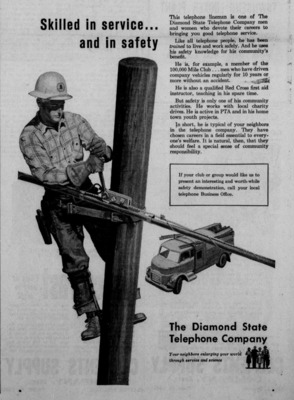Gendered Advertising During the 1960s
Gendered Advertising During the 1960s
Through my research searching through newspaper advertisements from the 1960s, there are noticeably fewer gendered advertisements in this decade. Many of the advertisements during this period do not feature people, rather they are textual advertisements. Although there are fewer newspaper advertisements, this does not point to an overall reduction of telephone service advertisements because there may have been an increase in advertisements elsewhere such as on the television or the radio.
Despite there being fewer gendered advertisements, gendered stereotypes and gender roles were still reflected in advertisements during the 1960s. As seen in Figures 1, 2 and 3, women are made out to be housewives and in charge of taking care of children and the home, and if they were employed, they were working in customer service (see Fig 4). In contrast, men were office workers and blue-collar workers (see Fig. 5 and 6). These are the same stereotypes that were seen in advertisements during the previous two decades.
Figures 1 and 2 do a great job of highlighting the gender expectations for women during the 1960s. Figure 1 shows a woman caring for a baby while speaking on the phone. This highlights the expectation for women to be the primary caregivers for their children while still being attentive to the needs of others. Figure 2 is similar as it has an image of a woman caring for her children as well as an image of the woman vacuuming while using the telephone. These advertisements show that by having a telephone, women are able to do a better job with their housework. This is a good marketing strategy for the time because the expectation was for women to be housewives, so if they had a telephone, it would not only make their lives better but also makes the lives of their husbands better because women are then able to spend more time on things to help her family and the home. Compared to advertisements focused on making the lives of men easier at work, advertisements featuring efficient housewives appeal to a larger demographic.
Teenagers Then and Now: Get off the Phone!
Just like in the 1950s, teenagers remained avid users of the telephone during the 1960s according to the article “On the Telephone Crazy Positions” (Fig.7). From the perspective of someone who was a teenager in the 2010s, I can see a lot of similarities between me and the teenagers in the article. The teenagers from the 1960s love to talk to their friends on the telephone and take all sorts of different positions while speaking on the telephone. Speaking from my perspective as a 22-year-old, this is similar to teenagers and young adults today. Now people like to talk on the phone while in bed, walking around, or while doing other activities, and it is difficult to separate us from our cellphones. This article was fascinating because although the 1960s and the 2020s are sixty years apart and technology has evolved immensely, the teenage experience during these two periods is similar.
